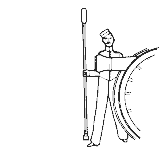The Gunner'Gunner' is the name given to a private soldier in the Artillery, but it means much more. It refers not only to rank, trade, profession or calling, but to our very 'tribe', if you like, because Gunners look upon themselves as a race apart. All members of the Regiment are Gunners, from the Master Gunner, St James' Park, who is a General, down to the newest recruit. The rank of Gunner goes back over 600 years. City of London archives dated September 1339 provide the earliest records of 'gonnes' in England; later they became known as 'guns'. 'Gunners', the men who manned them, are first mentioned in a list of 'persons of the Ordnance' dated 1344. The Gunner of the 14th Century was a civilian craftsman who made the gun and served it in action. When the King went to war he hired both. As the use of guns increased, they became Government-owned, their manufacture developed into an established industry, and the Gunner emerges as a military man skilled in the art of gunnery as it then existed. It was he who judged the elevation, laid the gun, and corrected the fall of shot. He was the expert in charge. Men called 'servitor Gunners' did the more mundane work of manning dragropes, loading, firing, sponging out etc. Pioneers, who formed part of the Artillery Train, did the digging.
The Gunner was intensely proud of his knowledge and skills, and considered himself superior to all other soldiers. Furthermore, he was not backward in letting them know it - in language not always calculated to win friends. Under the Board of Ordnance who ran the Artillery and Engineers as a kind of private army, he enjoyed more 'home comforts' and a discipline less strict than that prevailing in the rest of the Army, a factor which did not add to his popularity. In fact, up to the end of the 17th Century the Gunner had an evil reputation, particularly among foot soldiers who formed the bulk of the forces. Like most members of the working classes from which they came, these men were extremely superstitious. Few could read or write, and even those who could were incapable of appreciating the simplest technicalities. The intricacies of the Artilleryman's art were quite beyond their comprehension. To these simple souls the sights and sounds of a battery position were frightening. The thunderous explosions and sulphurous smoke, punctuated by the lurid profanity of the Gunners, their faces blackened by powder, their tempers tried by precocious pieces, conjured up visions of the infernal regions. They were convinced all Artillerymen were in league with the Devil! By 1547 the term 'servitor' had been dropped, and Artillerymen divided into classes paid according to merit and ability. Gunners received 1/- (10c) a day; others called 'inferior Gunners' or 'Canoneers', 8d, 6d, and 4d (7, 5 and 3 cents respectively). Artificers recieved 4d, other trained soldiers 6d. One Gunner was allocated to each piece of ordnance with one or more 'inferiors' as assistants. Labourers made up the rest of the detachment. A hundred years later the 'inferiors' were elevated to the rank of Matross. Gunners were now all on the same rate of pay, with the Matrosses receiving somewhat less. Each gun was now commanded by a Gunner assisted by a Matross. In the field, the additional men necessary to serve the guns came from the Infantry battalions, in coastal forts from the local garrison troops or militia. As these extras were usually untrained in artillery work the Gunners and their assistants had the unenviable job of licking them into some sort of shape before the first battle. With the introduction of the Bombardier in 1686, closely followed by the Corporal and Sergeant, the Artillery gradually became organised on a regimental basis, and the Gunner no longer found himself in charge of a gun. But although he suffered a reduction in status, by the beginning of the 18th Century he was becoming respectable. Infantry and Cavalry had come to appreciate the support they received from the guns, organisation and techniques had improved, while the old fears and prejudices were fast disappearing. The distinguished service the Gunners gave during the wars of the early 1700s went a long way towards earning them the title 'Royal Artillery' in 1716. Since then they have gone from strength to strength. You will sometimes hear old Gunners say, 'Once a Gunner, always a Gunner'. They mean that though a Gunner may retire from the Regiment or even transfer to some other arm of the service, he will always remain a Gunner at heart. He will continue to act up to the old traditions of the Regiment which nurtured him, and keep alive the old spirit of comradeship we value so much. WL Ruffell |
